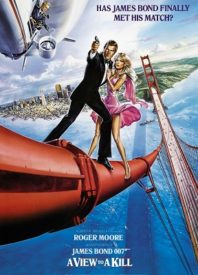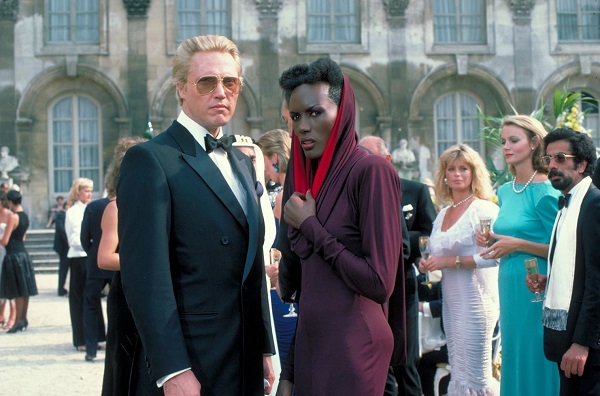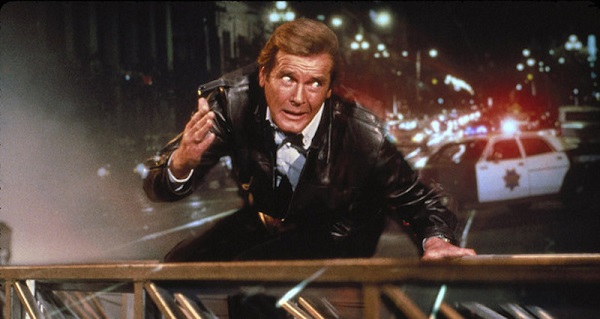
“On a mission, I am expected to sacrifice myself.”
John Glen returned for the third time as a 007 director, in this, Roger Moore’s final outing as Ian Fleming’s James Bond. This one is a weird one for me, one I tie with lots of nostalgia. It was the first Bond soundtrack I bought, although I didn’t get to see it in the theater. Moore was the iconic Bond for a lot of my generation. So as a young teen, when I finally saw this one on video, I was willing to forgive a lot, though even then I didn’t love it. Looking back, it’s far from Moore’s best, and it is very easy to see that the actor is, at this point, way too old. Or at least, he was too out of shape to play a tough secret agent, despite his charm and humor.
Cubby Broccoli and Micheal G. Wilson continue to produce the film. Meanwhile Wilson pulls double duty as a screenwriter alongside long time 007 scribe, Richard Maibaum. Together the pair concoct a story that sees a plan (much like that of Goldinger‘s). That plan is to destroy a resource in order to up the value of that same resource owned by the film’s villain, in this case, micro-chips.
The film’s baddie, Max Zorin (a perfect bit of casting of Christopher Walken, and a brilliant highlight of the film), runs Zorin Industries. He plans to set off a series of explosions along the San Andreas fault line to flood and sink Silicon Valley, leaving him the only game in town.
The film features some standout moments, like the ‘introduction’ of snowboarding to the world in the pre-credits sequence. Although all of its excitement and dramatic impact was ruined by using The Beach Boys to highlight it. There’s also a stunning leap off of the Eiffel Tower (culminating in a silly chase that sees Bond driving the front half of a car). But it also severely under serves its regular supporting cast. This is Lois Maxwell’s final appearance as Moneypenny. And it doesn’t give Desmond Llewellyn’s Q much to do beyond deliver exposition.
The film’s additional cast includes Moore’s friend Patrick Macnee as Tibbet. He assists Bond with his cover as the agent navigates the world of Zorin’s thoroughbreds. There’s the horribly miscast Tanya Roberts as Stacey Sutton, a young woman caught up in the conflict with Zorin. There’s the brilliantly used Grace Jones as Zorin’s aide, May Day. David Yip appears as American Agent Chuck Lee, and Patrick Bauchau is Zorin’s other, less than impressive henchman, Scarpine. And watch for a very brief, non-speaking appearance of Dolph Lundgren as one of General Gogol’s (Walter Gottel) men.
Alan Hume returns as the director of photography, who has served in that capacity since For Your Eyes Only. Peter Davies assumes the role of editor taking over from longtime editor John Grover. And John Richardson continues his work as Special Effects Supervisor having come aboard on Octopussy.
John Barry delivers his tenth 007 score, introducing a variety of themes in the film. He layers these varieties together to deliver one of his most enjoyable Bond renderings. He also worked with Duran Duran on the film’s main theme. They brought that music brilliantly to life during the credits sequence, once again, by Maurice Binder. John Taylor of Duran Duran had approached Broccoli at a party. He asked when they were going to have someone ‘cool’ do a Bond theme song. From this point on, they kicked the themes up a notch to reflect of the time they made the film.
And that works, because the cinematic version of 007 has always been a mirror of the times that they were created.
The production wasn’t without its woes. The 007 stage burnt down during the production of Ridley Scott’s Legend. And the shooting schedule had to be arranged to give time for Eon Productions to rebuild it. Peter Lamont continued to serve as Production Designer. And he completed his construction work and give us some truly wonderful sets. The new Albert R. Broccoli 007 Stage was commemorated on 7 January, 1985.
While Lamont’s team worked on sets, the production continued its globe-trotting. They took 007 to France, Iceland, around the UK, and of course, California. It doesn’t feel quite as exotic and expansive as other Bond films, and perhaps that’s one of the things that makes it feel smaller.
But that wasn’t the only issue. The production, like most Bond films, had a lot going for it, but plot ideas feel too recycled. Other plot points didn’t get the attention they needed. Those points included Zorin’s backstory as a ‘steroid kid’, and the Russians’ involvement in everything. There’s also the age of the lead, and the shifting towards a more violent form of storytelling. Something Moore was uncomfortable with all worked against the film. That’s to say nothing of the complete lack of chemistry between Moore and Roberts.
Walken, on the other hand, seems to be having a great time. And it feels like he and Barry’s score are trying to do as much heavy lifting as possible to elevate the film higher than it is. I was, and continue to be a fan of his performance, and Barry’s work in this film, and the theme song remains one of my favorites.
The music video, released to help promote the film, was shot on and around the Eiffel Tower. It featured the band, Duran Duran, riffing on the secret agent, and action beats of the film, all inter-cut with sequences from the film. It was cheesy fun, and helped propel the single up the charts.
Artist Dan Goozee returned to help promote the film with some gorgeous artwork. He created a poster that depicted Bond and May Day back to back. He also created a poster with 007 and Stacey standing astride one of the beams of the Golden Gate Bridge. Meanwhile Zorin hovers near by in a dirigible, gun at the ready. An advance teaser poster pictured 007 hanging off a rope ladder along the Eiffel Tower while May Day parachutes viciously towards him.
A View To A Kill was released on 24 May, 1985 in North America, and a few weeks later in the UK. And while it was successful, it didn’t do the box office the producers had hoped for. It reminded the creative team that it was definitely time to reposition Bond.
This is the first 007 that ends with the ‘James Bond Will Return’ tag sans the next film’s title. Fans would have to wait impatiently for that. Just as impatiently as they would for the reveal of the new actor. One who would be taking over the role from Roger Moore, who was finally hanging up his Walther.
I was among those fans who couldn’t wait to discover who the next Bond was going to be. I determined that whoever it was, they were the star of the first James Bond movie I saw on the big screen. No more videotape introductions for me. I was ready for something all new. Consequently the filmmakers of the next Bond perfectly tailored it for me, and remains one of my favorites. But that’s for next week.
Thank you again to DK Canada’s extensive 007 library, including Bond By Design: The Art of the James Bond Films. That library also includes James Bond: 50 Years of Movie Posters and The James Bond Encyclopedia.
- Release Date: 5/24/1985





